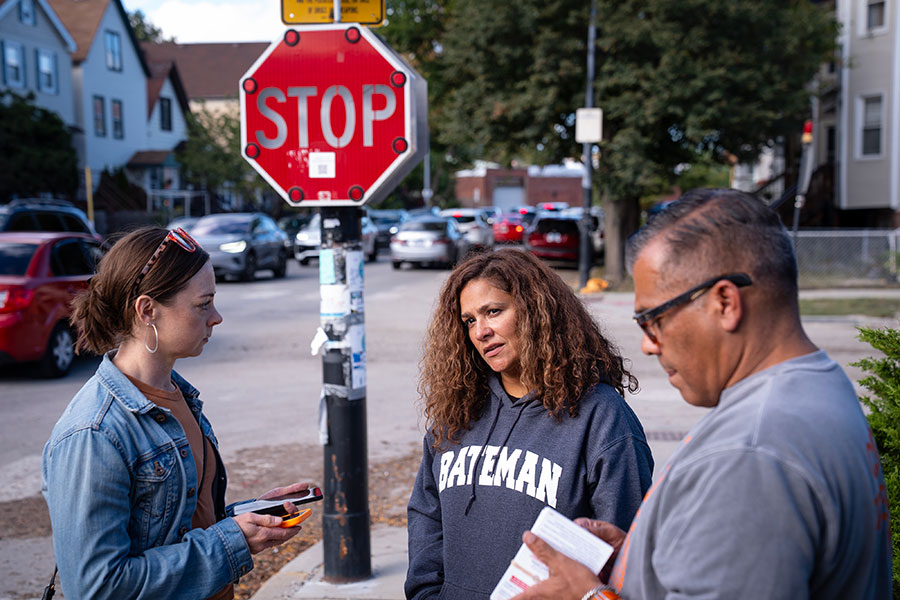It was three o’clock in the afternoon, dismissal hour at Roosevelt High School in Albany Park, where the student body is 74 percent Latino. A young white woman stood on the corner of Wilson and St. Louis avenues, with a whistle around her neck and a tab with the phone number of the Illinois Coalition for Immigrant and Refugee Rights. She was a watcher, a member of the Northwest Side Rapid Response team, ready to blow a signal at the sight of Immigration and Customs Enforcement officers.
“I’m never gonna understand the fear that it is to be brown under this administration, so I’m gonna stand on the corner and do what I can,” said the woman, who is on this corner three or four days a week. “There’s a lot of community involvement in this neighborhood. I asked what I could do at the alderwoman’s office, and they connected me with the school.”
On the opposite corner, Cirila Casales was standing behind her taco cart, hoping for some foot traffic. Born in Mexico, but a Chicagoan since 1986, and a citizen since 2020, she was carrying her passport, in case of a confrontation with ICE, which has specifically targeted street vendors.
“She’s not worried because she has papers,” said her son, Pedro Casales Jr., speaking for his mother, whose English is limited. “Right now, though, they don’t go with papers, they go with color.”
Ever since the ICE raids began in September, most of the customers have been white, since many Latinos are afraid to leave their homes. Community members have protected Cirila by escorting her from the corner to her home.
“A couple hours ago, a guy passed by saying, ‘Be careful of immigration,’” Pedro Jr. said. “It’s always quiet here, but out of nowhere, they decided to come, to hit our community.”
ICE has raided Albany Park twice, first on October 12, when officers tear gassed neighbors who gathered to protest their presence, then on October 21, when they pointed a gun at state Representative Hoan Huyhn. As Albany Parkers will tell you, this is the most diverse neighborhood in the city, with 40 different languages spoken in its public schools, and a population that is 45 percent Latino and 15 percent Asian. The restaurants on Kedzie Avenue display the international flavor: Sinya Mediterranean, Thai Valley Restaurant, Salam Restaurant, Tamales Mi Chula, Lebanese Meat Market. So is a Nigerian church. As a neighborhood of immigrants, Albany Park is a natural target for ICE, which is why it has developed one of the most active resistance networks of any neighborhood in the city.
Inside the office of Alderperson Rossana Rodriguez-Sanchez, whistles are available, as are signs for businesses warning that immigration agents are not welcome. The office hands out “know your rights” flyers and works with the Rapid Response Network to set up school patrols. (Rodriguez-Sanchez had a confrontation with ICE officers. She was following an SUV, honking her horn and blowing a whistle to warn neighbors. The SUV lured her into an alley, where an officer warned her to stop “impeding in our operation.”)
Lindo Michoacan, a Mexican restaurant at Lawrence and Kedzie avenues, has a sign on the door reading “NOTICE TO ALL ENFORCEMENT AGENTS. This is a private property. No one can enter without a legal and valid warrant. If you do not have a legal warrant, we will NOT OPEN THE DOOR.”
“It’s anybody, not just ICE,” said manager Alfredo Robledo, looking out over his dining room, which was mostly empty at lunchtime. “I worry about everybody: my family, my employees, our customers.”
Because so many customers are now afraid to venture out, Lindo Michoacan has begun providing free delivery. It’s not easy, though, because the restaurant is often two or three bodies short, since employees are afraid to come to work. If an ICE officer tried to enter the restaurant, “we would ask for a warrant, stop him at the door. Don’t even let him come in, not even to use the restroom.”
Down the street, Golden Crust Pizza and Tap had two Spanish signs in the window: “No Abran ICE!” and “Ice Fuera De Nuestras Comunidades!” The tavern’s owner, Jimmy Karagianes, is a native-born American, but he supports the neighborhood resistance to ICE. ICE is bad for the restaurant business: “When they first came to town, I went by a Mexican restaurant. Usually it’s 50 people; they had four tables full.” It’s also bad for his business as a landlord. When he tried to get into one of his building’s apartments to change the batteries on sensors, “no one would open the door. I’m the landlord, they wouldn’t open the door.” He also worries that his tenants will be detained by ICE.
At Roosevelt High School, the mostly Latino students streamed out the door, walking past a planter on which someone had scrawled “FUCK ICE!” No whistles sounded to warn them. ICE wasn’t in the neighborhood that day. But Albany Park is certain the migra will return, and when it does, Albany Park will be ready.



